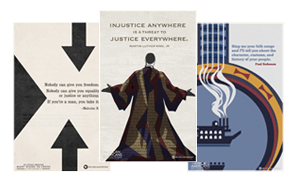Life After the Emancipation Proclamation ~ Lesson Plan
Lesson Overview
(Click here for a printer-friendly version of this lesson).
LESSON TITLE: Free but Not Free: Life After the Emancipation Proclamation
GRADE LEVEL: 9-12
TIME ALLOTMENT: Two 45-minute sessions
OVERVIEW
In this lesson, students explore the realities of life after the Emancipation Proclamation and learn about courageous individuals who fought against the inequalities African Americans experienced. In the Introductory Activity, students discuss what a “proclamation” is and examine what the Emancipation Proclamation promised African Americans. In the Learning Activity, students view video segments from The African Americans: Many Rivers to Cross to learn about what life was like during the Jim Crow era. Finally, in the Culminating Activity, students watch a video segment about Charles Hamilton Houston and Victor Hugo Green, two men who took courageous action against the inequalities African Americans faced. Students discuss the actions these men took and then, either as an in-class activity or for homework, students research and write a short essay about a historical African American figure who fought for equality during the Jim Crow era.
SUBJECT MATTER: Social Studies
LEARNING OBJECTIVES
After completing this lesson, students will be able to:
- Explain what a proclamation is and outline what the Emancipation Proclamation promised African Americans.
- Describe what Jim Crow laws were, including how they were reinforced and how they affected African Americans.
- Describe some of the reasons why tension existed between white people and African Americans after the Emancipation Proclamation.
- Discuss some of the people who made an impact in the fight for equality for African Americans, including the ways these individuals made a difference.
STANDARDS
From the Common Core Standards: Literacy in History/Social Studies, Science, and Technical Subjects, available online at http://www.corestandards.org/ELA-Literacy:
Common Core Standards, now adopted in over 40 states, are designed to help educators prepare students for success in college and careers by focusing on core knowledge and skills. The English Language Arts standards reflect the need for young people “to read, write, speak, listen, and use language effectively in a variety of content areas” including history/social studies. This curricular resource developed to accompany The African Americans: Many Rivers to Cross aligns most closely with the following Common Core Standards:
CCSS.ELA-Literacy.RH.9-10.2 Determine the central ideas or information of a primary or secondary source; provide an accurate summary of how key events or ideas develop over the course of the text.
CCSS.ELA-Literacy.RH.9-10.5 Analyze how a text uses structure to emphasize key points or advance an explanation or analysis.
CCSS.ELA-Literacy.RH.11-12.2 Determine the central ideas or information of a primary or secondary source; provide an accurate summary that makes clear the relationships among the key details and ideas.
CCSS.ELA-Literacy.RH.11-12.4 Determine the meaning of words and phrases as they are used in a text, including analyzing how an author uses and refines the meaning of a key term over the course of a text (e.g., how Madison defines faction in Federalist No. 10).
CCSS.ELA-Literacy.RH.11-12.5 Analyze in detail how a complex primary source is structured, including how key sentences, paragraphs, and larger portions of the text contribute to the whole.
From the National Standards for United States History for grades 5-12, available online at http://www.nchs.ucla.edu/Standards/us-history-content-standards:
Era 5: Civil War and Reconstruction
- Standard 3: How Various Reconstruction Plans Succeeded or Failed
- Standard 3B: The student understands the Reconstruction programs to transform social relations in the South.
- Grades 7-12: Analyze how African Americans attempted to improve their economic position during Reconstruction and explain the factors involved in their quest for land ownership.
- Standard 3B: The student understands the Reconstruction programs to transform social relations in the South.
MEDIA COMPONENTS
Video
The African Americans: Many Rivers to Cross, selected segments.
Access the video segments for this lesson at the Video Segments Page.
Segment 1: Life After the Emancipation Proclamation
This video describes the continued oppression of African Americans following the Emancipation Proclamation.
*Note: This video contains graphic images of lynchings.
Segment 2: The Great Migration
This video explores the Great Migration and the idea that the Emancipation Proclamation did not live up to its promises.
Segment 3: The Subjugation of African Americans
The segment provides an overview of the demonization of African Americans following the Emancipation Proclamation and the propaganda campaign that served to reinforce Jim Crow.
Segment 4: Resenting Prosperity and Equality
This video segment describes how white people’s resentment of African Americans’ prosperity and their alleged achievement of equality bred violence.
Segment 5: The Realities of Separate But Equal
Learn about the efforts of Charles Hamilton Houston and Victor Hugo Green, both of whom fought for equality for African Americans.
Websites
- PBS LearningMedia: Emancipation Proclamation (1863) and Resource Materials
Note: This website contains a transcript of the Emancipation Proclamation, which you will be using in the lesson. The site also contains an image of the original document and a background essay that you may want to use in further activities.
- PBS LearningMedia: The Rise and Fall of Jim Crow
MATERIALS
For the class:
- Computer, projection screen, and speakers (for class viewing of online video segments)
For each student:
- One copy of the Emancipation Proclamation (1863): Transcript
- One copy of the Historical Figure Assignment
PREP FOR TEACHERS
Prior to teaching this lesson, you will need to:
Preview all of the video segments used in the lesson. Prepare to watch them using your classroom’s Internet connection.
On each computer in your classroom, bookmark the website “The Rise and Fall of Jim Crow”.
Using a social bookmarking tool such as del.icio.us or diigo (or an online bookmarking utility such as portaportal) will allow you to organize all the links in a central location.
For each student, print out and make copies of the Emancipation Proclamation transcript (accessible via the PBS LearningMedia website listed above – see the “For Teachers” section at the bottom of the page) and the Historical Figure Assignment.
Find educational resources related to this program - and access to thousands of curriculum-targeted digital resources for the classroom at PBS LearningMedia.
Visit PBS Learning Media






